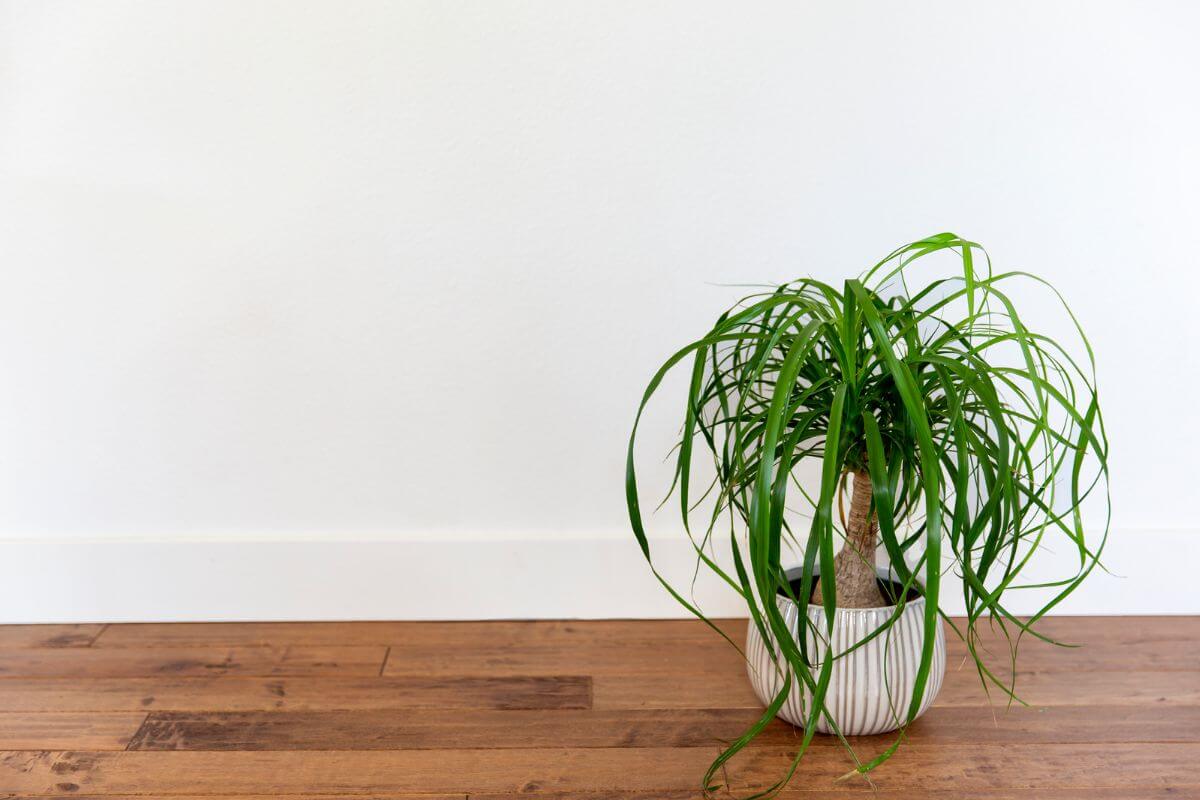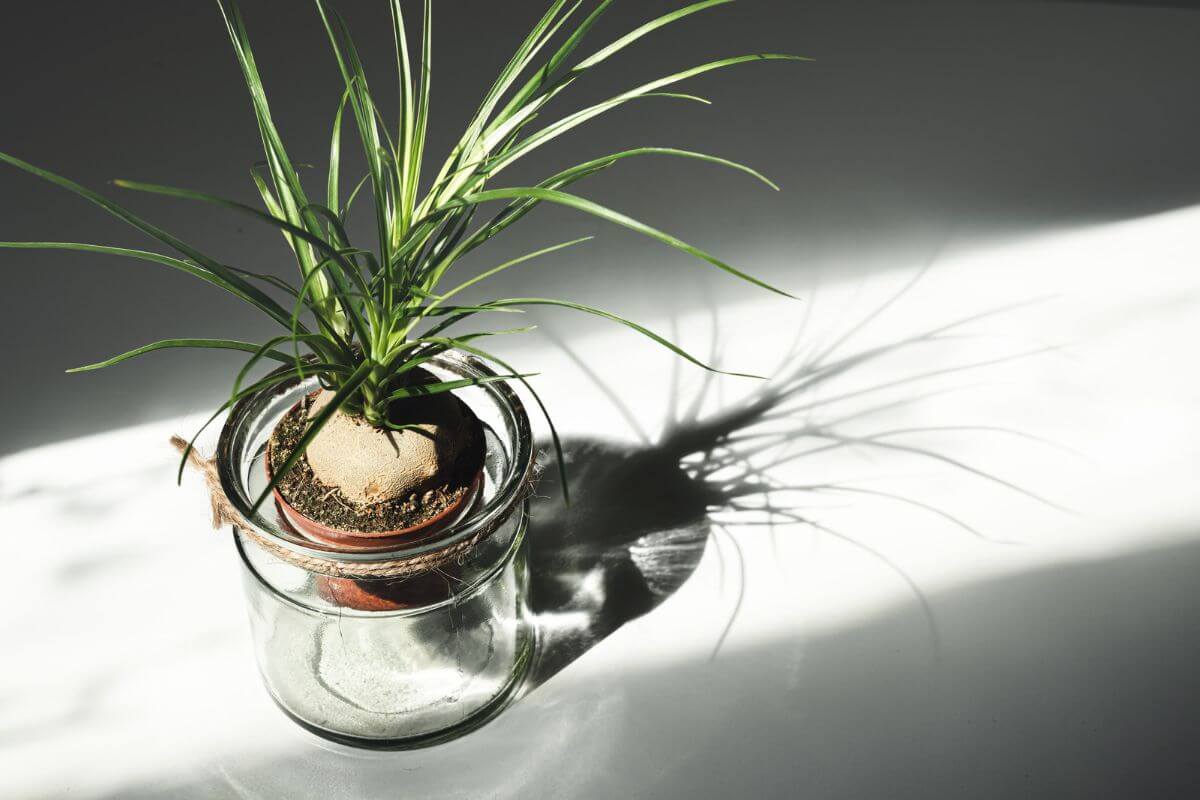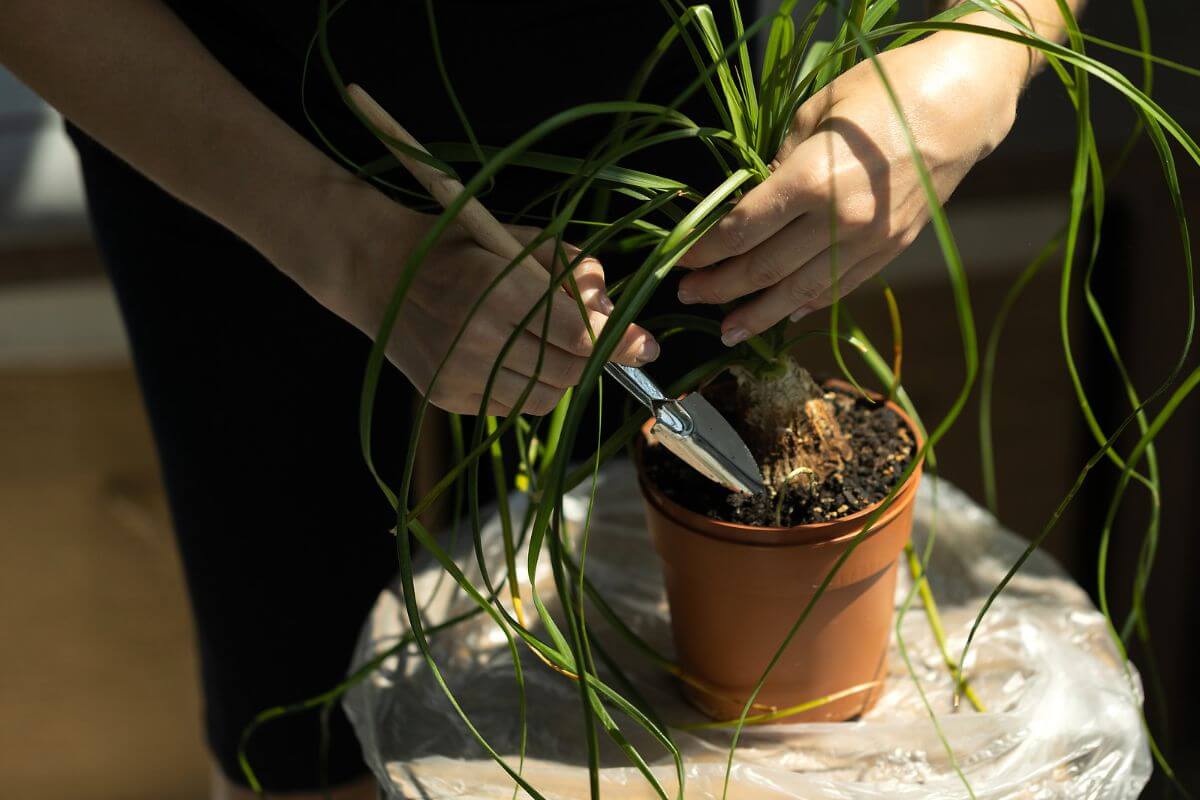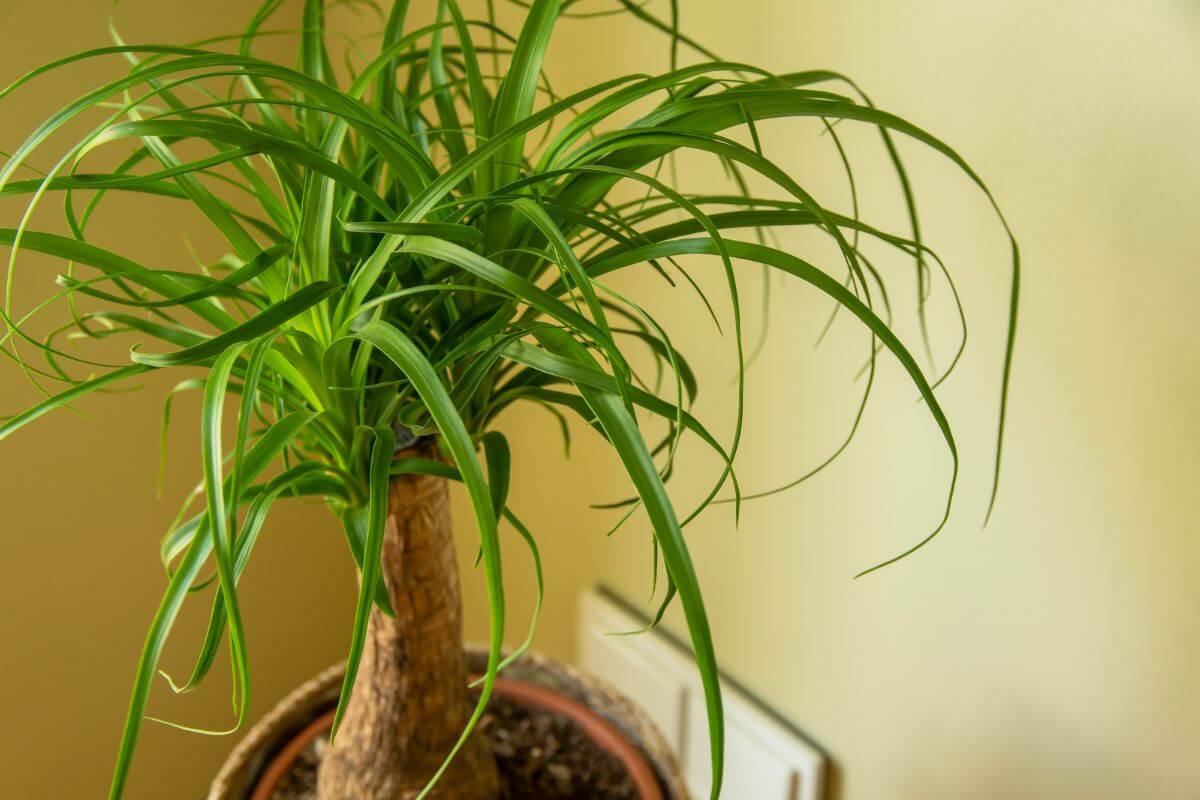An original and unusual plant, the Beaucarnea recurvata, better known as the Ponytail Palm is a popular houseplant addition to many homes and offices.
When cultivated outdoors, this houseplant will actually grow to be an enormous tree towering over your yard offering lots of shade. When indoors, it brings a tropical feel with their long fronds.
- Related: List of Houseplants
This guide will show you everything there is to know about the ponytail palm and how to care for them.
Ponytail Palm Plant Overview

Native to the more arid regions of Central America, this evergreen shrub or tree, which is, in reality, a succulent, and it’s easy to cultivate indoors.
Indoors it may reach six to eight feet tall with a three to five-foot spread in width. Outdoors, the ponytail palm can reach heights of thirty feet.
A member of the Asparagaceae family, the ponytail palm or Elephant’s foot is really not a palm at all. It is closely related to both the Yucca and Agave desert plants. It’s also related to the asparagus we eat.
They feature a type of stump that forms the base of the trunk, which then tapers off into a thinner trunk towards the top. At the top, rosettes of long green leaves form something resembling a ponytail, which is where its name comes from. Outdoor leaves may grow to six feet in length.
When cultivated indoors, they resemble small trees with bulbous stems topped with flowing green leaves shaped like straps or grass.
Ponytail Palm Care Guide
The ponytail palm is a slow grower that lives a long life and can often outlive its owners. They can survive for decades, even centuries in the right environment.
Over time, the tree can grow as high as six feet with the proper care and conditions. Indoor leaves may reach three feet in length.
It can take as many as five years for an indoor plant to double in size. They can be planted at any time of the year for indoor cultivation and are usually planted in shallow pots or dishes. Outdoor planting should be done in the springtime.
The ponytail palm is a great plant for beginners or people with limited time to dedicate to gardening. It can be planted and forgotten without being harmed, requiring adequate light and regular watering during the growing season.
Soil for the Ponytail Palm
As a native of arid semi-desert areas in Central America, it will need to be planted in a sandy soil bed that is rich in organic matter and nutrients, regardless of whether it is planted indoors or out.
If you are planting this as an indoor plant, a cactus or succulent potting mix is ideal with some peat added to enrich it.
You can also mix one part sand, one part perlite, and one part potting mix together to create your own mix.
The pot you choose needs good drainage holes for excess water. A clay pot is ideal as it is porous and will help in drying out the soil bed more quickly.
Light for the Ponytail Palm

The ponytail palm loves full bright sunlight as long as it’s indirect light. Avoid direct sunlight as that can lead to scorched leaves.
Place this plant in a sunny window or in a location that receives lots of bright light.
When outdoors, be sure it gets partial shade to stay out of direct sun exposure.
Water and Humidity for the Ponytail Palm
During its growing season, the ponytail palm will need to be watered every week or bi-weekly. The bulbous trunk of this tree stores water for the plant’s survival, so it should not be overwatered.
During the winter months, it can be watered on a monthly basis. Let the soil bed dry out between waterings to avoid overwatering.
You can soak your ponytail palm but you will have to let all of the excess water drain from the pot. Any water remaining in a dish underneath your container should be tossed. The plant should not be left to stand in water.
If you are cultivating your ponytail palm outside, it will probably not require watering if your area gets some rain on a regular basis. In dryer, arid climates, or areas that suffer from drought, you can water your tree every two weeks.
Temperature for the Ponytail Palm
As a native of Central America, these trees love warm, dry conditions and temperatures that generally sit above 60° Fahrenheit. They can tolerate temperatures that drop as low as 50° F, but not for prolonged periods.
In the wintertime, do not leave your palm near windows if they are cold at night. Ponytail palms can be damaged if exposed to freezing temperatures. These plants should avoid being positioned near drafts, as well as air conditioning or heating vents, as foliage may dry out.
Ponytail palms can be placed outside on a porch or in a yard during the summer. Any transitioning from indoors to outdoors should be done gradually. When the temperatures dip below 50°F during the nighttime, bring the plant back indoors.
Fertilization for the Ponytail Palm
During the growing season, your ponytail palm can be fed every 1-2 weeks with a liquid fertilizer to aid its continual growth. You can also use slow-release pellets at the beginning of spring. Fertilization should be reduced in the winter season.
Pruning and Repotting the Ponytail Palm

Any type of leaf that shows damage can just be trimmed back to healthier tissue. If the ponytail palm produces pups or offsets, creating secondary shoots, you can prune these off, concentrating on the central trunk. Some people do enjoy having this plant with many stems for its decorative appearance.
There’s no real need to prune as it’s a low growing plant.
As a single stem plant, you should avoid pruning the ponytail palm itself as could expose the trunk to rot or mildew, and be left without any greenery.
If you want to grow a larger, multiple trunk ponytail palm, check out the guide on how to grow multiple trunks on the ponytail palm.
To grow your ponytail palm indoors, place it in a small container or pot, ideally with cactus potting mix with some peat added.
Repotting should be done in the spring. If you wish to encourage the growth in size of your plant, make it a point to repot annually. If you see that the roots are growing around the root ball, you should also repot.
If you prefer it to maintain its appearance as a small tree or houseplant, you can repot it every other year or every third year. Ponytail palms do exceptionally well in pots that slightly contain the roots, so don’t feel that you must pot to a larger size container when repotting.
When you do repot, use a pot that is only an inch larger at the most than the previous container. Moving them to much larger containers may cause them to receive too much water during waterings.
Do remember when handling the plant, that its leaves have serrated edges, so exercise caution. A good pair of gardening gloves can protect your hands.
Propagating the Ponytail Palm
The propagating of this tree may be assisted if pups or offsets (baby plants) begin growing at the base of the mother plant. The difficulty will be that these pups usually do not have roots.
These can be removed, and each placed in its own container when the pup reaches at least four inches in height. Before replanting the pups in a soil bed, let the cut wound heal.
Use rooting hormone on the cut end of the pup, to stimulate the growth of roots on the offset once placed in its own pot.
Normally, ponytail palms do not flower when cultivated indoors, so the production of viable seeds is close to nil.
To ensure success when propagating, seeds should be used if they can be found. If you are lucky enough to find seeds, they can be sown in the springtime when temperatures are 68° F or above.
Ponytail Palm Toxicity and Pets
According to the ASPCA (American Society for the Prevention of Cruelty to Animals), the ponytail palm is non-toxic for dogs, cats, and horses. It is also non-toxic for humans.
Ponytail Palm Pests, Diseases, and Problems

As with most indoor plants, your ponytail palm will be susceptible to mealybugs, scale, and spider mites. Insecticidal soaps or oils such as neem oil are organic methods for dealing with pest infestations.
Potential diseases include bacterial leaf streak, leaf spots, and stem rots. The most common cause of rotting and fungal infections is overwatering.
Brown leaf tips are usually due to overwatering, underwatering, excessive fertilization, or a build-up of salts in the soil bed. The brown tips should be trimmed off.
If your plant’s leaves are turning yellow and dropping, it is most likely due to overwatering or a drainage block in its pot. Leaf blades will turn brown and somewhat crispy if the plant is left dry for too long a period.
Growing the Ponytail Palm Tree Outdoors
Growing this succulent plant outdoors in your garden will only be possible in regions with warmer climates. When cultivated outdoors, this plant needs exposure to sunlight.
If you are transplanting a ponytail palm from a pot indoors, you will need to expose the palm gradually to increased light and a different outdoor temperature over the course of several weeks.
Outdoors, your palm will thrive in bright indirect sunlight and with generous watering. However, the watering should be done infrequently. The tree will store water in its trunk.
The location you choose should also feature well-draining soil, because this plant is at risk for root rot if left in a soggy soil bed. Clay-based soil would be counterproductive because of its tendency to hold water.
Outdoor ponytail palms will need years to branch out. Only established, mature palms will bloom.
Ponytail Palm Care Final Thoughts
With its low maintenance, forgiving nature, and lush curly leaves, the ponytail palm is an attractive, decorative plant that will add a bit of pizzazz to any interior decorating theme.
It is ideal for beginners, gardeners with little time, or people who travel often. That’s why it’s one of the more popular houseplants.
For other popular houseplant and palmcare guides, check these out:
- Bamboo Palm Care and Grow Guide
- Majesty Palm Care and Grow Guide
- Queen Palm Care and Grow Guide
- Polka Dot Plant Care and Grow Guide
- Wandering Jew Plant (Spiderwort) Care and Grow Guide
Ponytail Palm Care FAQs
What kind of sunlight does a ponytail palm need?
The ponytail palm needs full sun but not direct sunlight. This means that it requires some shade during midday hours. It can also survive in medium and low-light conditions as well.
Is the ponytail palm an indoor plant?
Yes, the ponytail palm can be an indoor plant, as well as an outdoor plant. You just have to make sure that it gets enough light. If you live somewhere where there isn’t much sunshine, then you may want to consider growing it outside instead.
How big do ponytail palms get?
Ponytail palms can get as big as 8 feet tall and 5 feet wide when grown indoors. When they’re grown outdoors, they grow even larger, to 30 feet tall.
How do you take care of a potted ponytail palm?
Potted ponytail palms are easy to take care of. They don’t require special attention like other plants. Just keep them watered regularly so that their roots stay moist. In addition, give them plenty of space to spread out. Don’t let them crowd each other. Repot every two to three years, so they continue growing healthily.
Is it OK to trim a ponytail palm?
Yes, it’s good to trim the ponytail palm once in a while. Trimming helps remove dead foliage and keeps the plant looking fresh. Be careful though; never cut off all the leaves on the same side of the stem. Doing so could cause the plant to lose balance and topple over. Also, avoid cutting into the base of the plant. Cutting near the bottom of the plant causes the plant to become weak and prone to disease.
Do ponytail palms bloom?
Yes, ponytail palms can bloom throughout the year, but only after several years of growth first. Ponytails usually flower between May and August. Once flowering has begun, the flowers will last about four weeks before falling off naturally.
How to grow multiple trunks on a ponytail palm?
Growing multiple trunks on a ponytail palm isn’t too difficult All you’ll need to do is repot your palm annually. The process involves removing the old potting mix from around the trunk and replacing it with new potting mixture. Then, place the palm back inside the container. Afterward, fill up the hole with additional soil until the topsoil level reaches the rim of the pot. Finally, use a pencil eraser to smooth down the surface of the soil. Do this again next spring.


